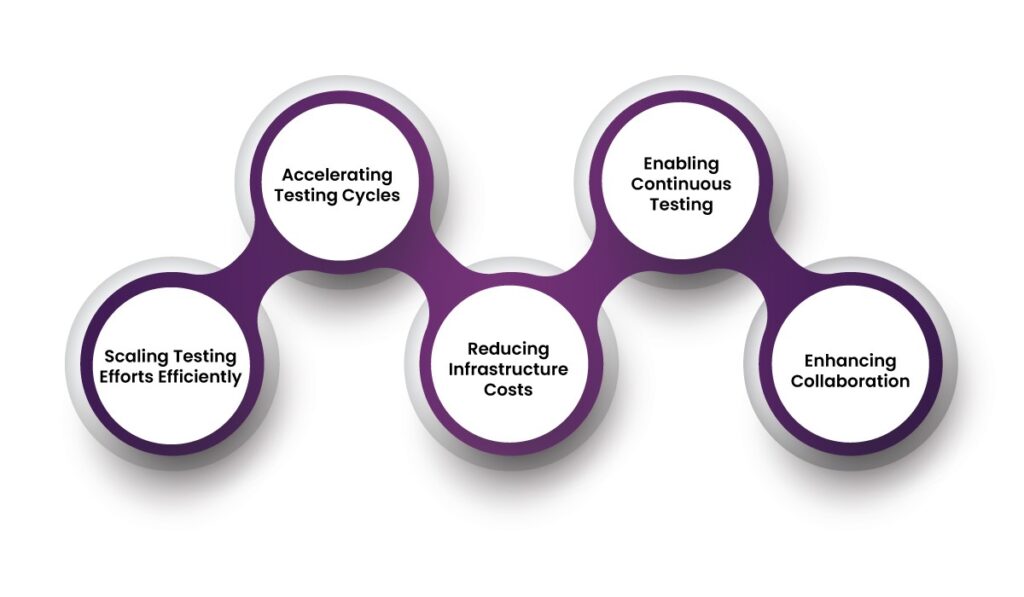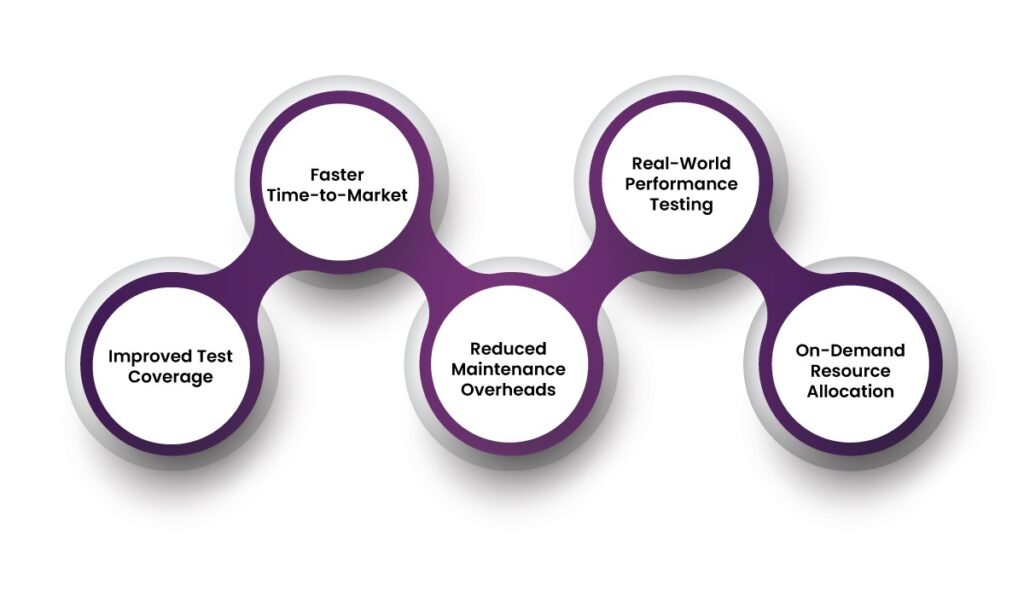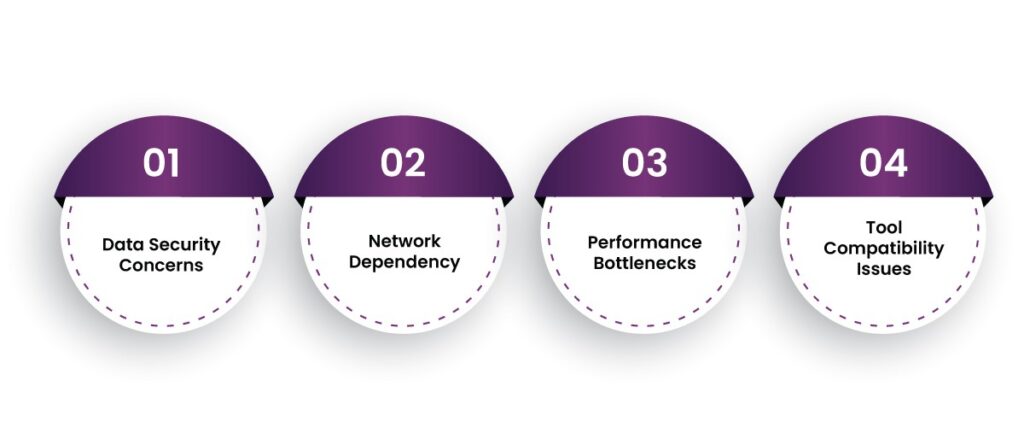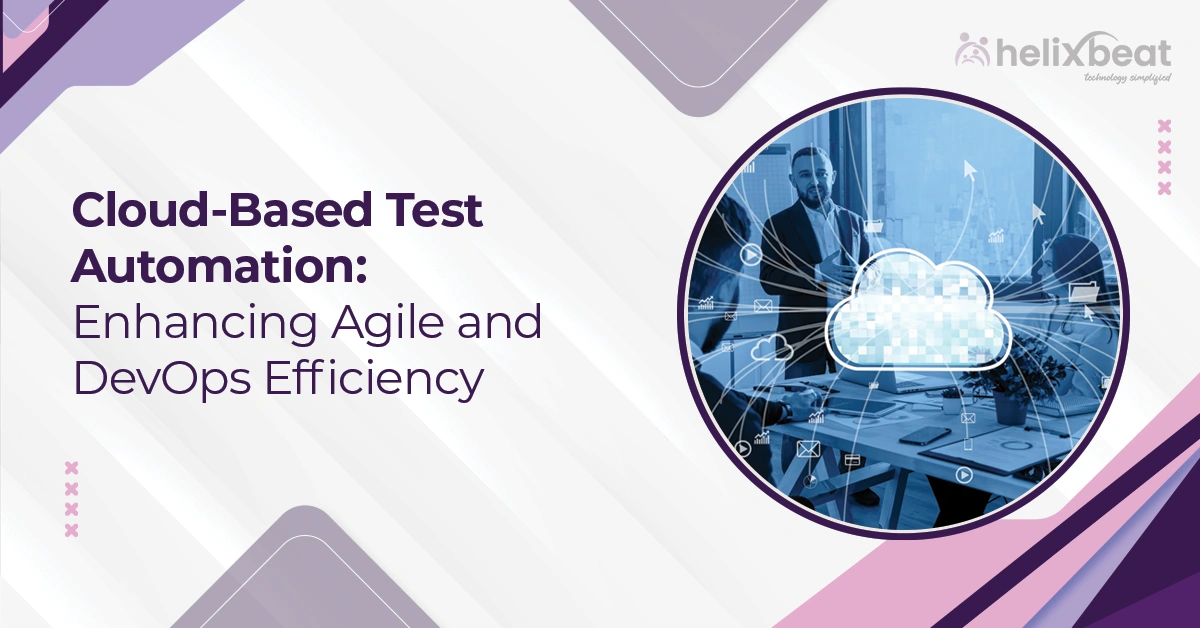How do modern businesses ensure their software remains reliable, scalable, and high-performing without slowing down development cycles? The answer lies in cloud testing.
Cloud-based test automation has transformed how enterprises approach software quality. With the rapid adoption of Agile and DevOps methodologies, organizations need scalable, cost-efficient, and real-time testing solutions. Cloud testing provides exactly that—enabling teams to run automated tests on a global infrastructure without the hassle of maintaining expensive on-premise test environments.
This blog explores how cloud-based test automation enhances Agile and DevOps efficiency, the key benefits it offers, and why it is essential for modern software development.
Table of Contents
What is Cloud Testing?
Cloud testing is a software testing approach that utilizes cloud computing environments instead of traditional on-premise setups. It allows teams to conduct functional, performance, security, and compatibility testing on demand while leveraging scalable cloud infrastructure.
Characteristics of Cloud Testing:
- Scalability: Supports large-scale test execution without requiring additional hardware investments.
- Global Accessibility: Enables testing from different geographical locations for real-world performance validation.
- Cost-Efficiency: Reduces the need for expensive infrastructure by utilizing cloud-based resources on a pay-as-you-go model.
- Automation Integration: Seamlessly integrates with automation tools to support continuous testing.
How Cloud Testing Enhances Agile and DevOps Efficiency?
Cloud testing is transforming the way Agile and DevOps teams ensure software quality by offering speed, scalability, and seamless integration with modern development workflows.
1. Accelerating Testing Cycles
Agile and DevOps teams operate in high-speed development environments where rapid iterations are critical. Cloud testing accelerates testing by providing instant access to pre-configured environments, eliminating the delays caused by manual setup and infrastructure limitations.
Example: A global e-commerce company can instantly test its website across multiple devices and browsers using cloud platforms like BrowserStack or Sauce Labs, ensuring a seamless shopping experience for users worldwide.
2. Enabling Continuous Testing
Continuous testing is an essential part of DevOps, ensuring that every new code update is validated before deployment. Cloud testing integrates seamlessly with CI/CD pipelines, enabling automated test execution whenever new code is committed.
Example: A financial services firm integrates cloud testing with Jenkins to run automated regression tests after every code update, ensuring stability and security in its applications.
3. Scaling Testing Efforts Efficiently
Cloud-based test automation allows teams to execute test cases across thousands of virtual machines and real devices simultaneously, ensuring broad test coverage without hardware constraints.
Example: A gaming company leverages cloud testing to verify its mobile game’s performance across various devices and operating systems, preventing compatibility issues before launch.
4. Reducing Infrastructure Costs
On-premise testing setups require significant investment in hardware, software licenses, and maintenance. Cloud testing eliminates these costs by offering a scalable, pay-per-use model, making high-quality testing accessible even for startups and mid-sized companies.
Example: A tech startup reduces testing expenses by utilizing AWS Device Farm for mobile app testing instead of purchasing and maintaining a large set of physical test devices.
5. Enhancing Collaboration
With remote and globally distributed teams becoming the standard, cloud-based test automation fosters collaboration by providing centralized access to test results, logs, and performance reports.
Example: A multinational healthcare company enables its QA teams across different time zones to work together seamlessly using cloud-based test management tools, ensuring efficient issue resolution and faster deployments.
Cloud testing not only streamlines testing processes but also enhances the overall efficiency of Agile and DevOps teams, making software releases faster, more reliable, and cost-effective.

Benefits of Cloud-Based Test Automation
Cloud testing offers a modern, scalable, and efficient approach to software testing, helping businesses enhance quality while accelerating delivery. Here’s how it adds value:
1. Faster Time-to-Market
In today’s competitive market, rapid software releases are crucial. Cloud testing automates test execution across various environments, eliminating manual delays. By leveraging cloud-based test automation, businesses can detect defects early and resolve them quickly, ensuring high-quality releases without disrupting development timelines.
2. Real-World Performance Testing
Applications must perform well under varying conditions, such as different network speeds, geographic locations, and user loads. Cloud testing enables teams to simulate real-world environments, identifying potential performance bottlenecks before deployment. This ensures that applications remain responsive and reliable, regardless of location or internet connection.
3. Improved Test Coverage
Traditional on-premise testing limits the number of devices and operating systems that can be tested. With cloud infrastructure, businesses gain access to an extensive range of browsers, platforms, and mobile devices, enabling comprehensive test coverage. This ensures applications work seamlessly across all user environments.
4. Reduced Maintenance Overheads
Maintaining physical testing environments requires constant updates, patches, and monitoring. With cloud-based test automation, service providers manage these updates, reducing maintenance efforts and allowing QA teams to focus on improving test strategies instead of infrastructure management.
5. On-Demand Resource Allocation
One of the biggest advantages of cloud testing is flexibility. Businesses can scale test environments up or down as needed, optimizing costs and resource allocation. Instead of investing in expensive hardware, companies can provision and decommission cloud resources based on testing demands, ensuring efficiency without unnecessary expenses.
Cloud-based test automation not only streamlines the testing process but also enhances scalability, cost efficiency, and reliability, making it a game-changer for modern software development teams.

Challenges of Cloud-Based Test Automation and How to Overcome Them
While cloud testing offers numerous advantages, it also presents challenges that businesses must address to ensure smooth implementation. Here’s a look at the key obstacles and how to overcome them.
1. Data Security Concerns
One of the primary concerns in cloud testing is safeguarding sensitive data. Since cloud environments involve third-party providers, there is a risk of unauthorized access or data breaches. To mitigate this, organizations should implement robust security measures, such as encryption, multi-factor authentication, and role-based access controls. Additionally, working with cloud providers that comply with industry regulations like HIPAA, or ISO 27001 enhances data security.
2. Network Dependency
Cloud-based test automation relies on stable internet connectivity. Any network disruptions can delay test execution and impact results. To overcome this, businesses should opt for cloud providers that offer high uptime guarantees and distributed data centers to reduce latency. Using network monitoring tools can also help identify potential disruptions early and ensure a smooth testing process.
3. Performance Bottlenecks
Virtualized cloud environments may not always provide an accurate representation of real-world performance, leading to discrepancies in test results. To address this, organizations can adopt a hybrid testing strategy that combines cloud testing with on-premise performance testing. Running tests in multiple environments helps validate application behavior under various conditions, ensuring more reliable results.
4. Tool Compatibility Issues
Not all automation tools integrate seamlessly with cloud testing platforms, creating compatibility challenges. To prevent integration issues, businesses should choose cloud testing providers that support a wide range of automation frameworks and testing tools. Additionally, using open-source or cloud-native testing tools can offer greater flexibility and scalability in test execution.
By proactively addressing these challenges, businesses can maximize the benefits of cloud-based test automation while ensuring security, performance, and efficiency in their testing processes.

Helixbeat’s Cloud Testing Solutions
Helixbeat is a trusted provider of cloud-based test automation, offering scalable and cost-effective solutions tailored for Agile and DevOps teams. Our advanced testing capabilities include:
- Comprehensive Test Coverage: Ensuring applications work across multiple platforms and devices.
- Automation Integration: Seamless CI/CD integration for continuous testing.
- Security and Compliance: Robust security measures to protect sensitive data.
- Performance Testing: Simulating real-world conditions for accurate test results.
How Helixbeat Enhances Your Cloud Testing Strategy?
- End-to-End Functional Testing: Verifies that your software meets business requirements.
- Performance and Load Testing: Identifies bottlenecks and optimizes system performance.
- Security Testing: Detects vulnerabilities and ensures compliance with industry standards.
- Mobile and Web Testing: Delivers seamless experiences across all platforms.
With Helixbeat’s cloud testing solutions, businesses can streamline their testing processes, improve software quality, and accelerate time-to-market while maintaining security and scalability.
Final Words
Cloud testing is now an indispensable part of Agile and DevOps workflows, offering scalability, flexibility, and cost-efficiency. By integrating cloud-based test automation, businesses can accelerate software delivery while maintaining high-quality standards.
Helixbeat’s advanced cloud testing solutions empower teams to achieve faster, more reliable testing, ensuring seamless user experiences. Whether you’re a startup or an enterprise, adopting cloud-based test automation is the key to staying ahead in today’s competitive software landscape.
Ready to transform your testing process? Partner with Helixbeat today and unlock the full potential of cloud testing!
FAQs
1. Which industries benefit the most from cloud testing?
Industries like e-commerce, banking, healthcare, and gaming benefit the most, as they require extensive testing across multiple devices and environments.
2. How does cloud testing support Agile and DevOps teams?
Cloud testing enables continuous testing, faster releases, and seamless integration with DevOps pipelines, ensuring high software quality.
3. What are the security risks associated with cloud testing?
Security risks include data breaches, unauthorized access, and compliance violations, which can be mitigated with encryption, access controls, and cloud security best practices.
4. How can businesses reduce cloud testing costs?
Businesses can optimize costs by using pay-per-use cloud testing services, selecting scalable test environments, and automating repetitive test cases.
5. What are the top cloud testing tools?
Popular cloud testing tools include BrowserStack, Sauce Labs, AWS Device Farm, and Selenium Grid.
6. Does cloud testing support mobile applications?
Yes, cloud testing allows mobile app testing on real and virtual devices, ensuring cross-platform compatibility.














